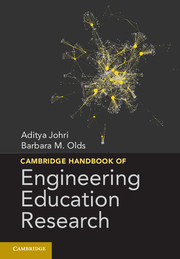Book contents
- Frontmatter
- Dedication
- Contents
- Editors
- Contributors
- Foreword
- Acknowledgments
- Introduction
- Chapter 1 Chronological and Ontological Development of Engineering Education as a Field of Scientific Inquiry
- Part 1 Engineering Thinking and Knowing
- Part 2 Engineering Learning Mechanisms and Approaches
- Chapter 8 Problem-Based and Project-Based Learning in Engineering Education
- Chapter 9 Case Studies in Engineering
- Chapter 10 Curriculum Design in the Middle Years
- Chapter 11 Engineering Design Education
- Chapter 12 Adaptive Expertise and Knowledge Fluency in Design and Innovation
- Chapter 13 Learning Disciplinary Ideas and Practices Through Engineering Design
- Part 3 Pathways into Diversity and Inclusiveness
- Part 4 Engineering Education and Institutional Practices
- Part 5 Research Methods and Assessment
- Part 6 Cross-Cutting Issues and Perspectives
- Index
- References
Chapter 9 - Case Studies in Engineering
Published online by Cambridge University Press: 05 February 2015
- Frontmatter
- Dedication
- Contents
- Editors
- Contributors
- Foreword
- Acknowledgments
- Introduction
- Chapter 1 Chronological and Ontological Development of Engineering Education as a Field of Scientific Inquiry
- Part 1 Engineering Thinking and Knowing
- Part 2 Engineering Learning Mechanisms and Approaches
- Chapter 8 Problem-Based and Project-Based Learning in Engineering Education
- Chapter 9 Case Studies in Engineering
- Chapter 10 Curriculum Design in the Middle Years
- Chapter 11 Engineering Design Education
- Chapter 12 Adaptive Expertise and Knowledge Fluency in Design and Innovation
- Chapter 13 Learning Disciplinary Ideas and Practices Through Engineering Design
- Part 3 Pathways into Diversity and Inclusiveness
- Part 4 Engineering Education and Institutional Practices
- Part 5 Research Methods and Assessment
- Part 6 Cross-Cutting Issues and Perspectives
- Index
- References
Summary
What Are Case Studies?
What are “cases” or “case studies”? Cases are narratives that present real-life scenarios/problems and allow students to experience how professionals address problems encountered in the field. Cases have three main elements: (1) they are based on real-life events or realistic situations that allow students to experience problems they are not likely to encounter first-hand; (2) they present both contextual and technical information that is based on careful research and study; (3) they may present no clear-cut solutions to allow students to develop multiple perspectives (Merseth, 1994). Hence, cases mimic real-world scenarios that engage students in solving authentic problems and experiment within the safe confines of a classroom (Demarco, Hayward, & Lynch, 2002).
The use of case studies has a long and effective history in business, law, and medical fields to teach students the complexities and ill-structured nature of those disciplines (Herreid, 2007; Mayo, 2004). Case-based teaching dates back to 1870, when Christopher Langdell, a law professor, argued that using actual legal cases was the best way to study law (Garvin, 2003). Langdell stated that using cases would develop students’ understanding “via induction from a review of those appellate court decisions in which the principles first took tangible form” (Garvin, 2003). Case studies also formed the instructional method at the Harvard Business School in 1908 (Merseth, 1991). However, unlike in law schools, case study implementation was slow in business schools owing to the lack of ready-made cases and faculty expertise in teaching with cases (Merseth, 1991). The use of cases became predominant at Harvard Business School after Wallace B. Donha became the Dean in 1919 and supported faculty to gain experience in teaching with cases. He also created the Bureau of Business Research to put together high-quality teaching materials including cases (Merseth, 1991). Case-based instruction has also been implemented in medical education via problem-based learning where students learn in cooperative groups by studying the records of an actual patient (Williams, 1992). See Chapter 11 by Atman, Borgford-Parnell, McDonnell, Eris, and Cardella in this volume for a discussion of the history of problem-based learning in medical education at McMaster University. Within science, technology, engineering, and mathematics (STEM) disciplines, James B. Conant at Harvard University was the first science educator in the late 1940s to teach an entire course using case studies via the lecture format (Conant & Van Deventer, 1951).
- Type
- Chapter
- Information
- Cambridge Handbook of Engineering Education Research , pp. 161 - 180Publisher: Cambridge University PressPrint publication year: 2014
References
- 15
- Cited by

